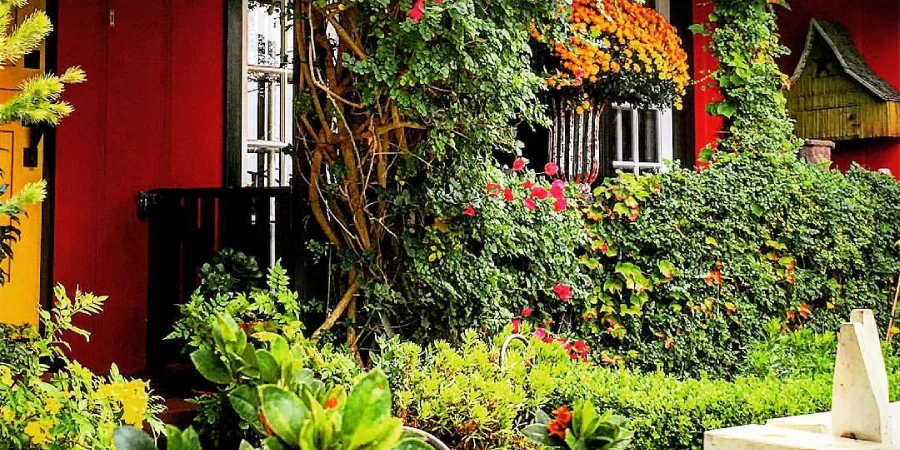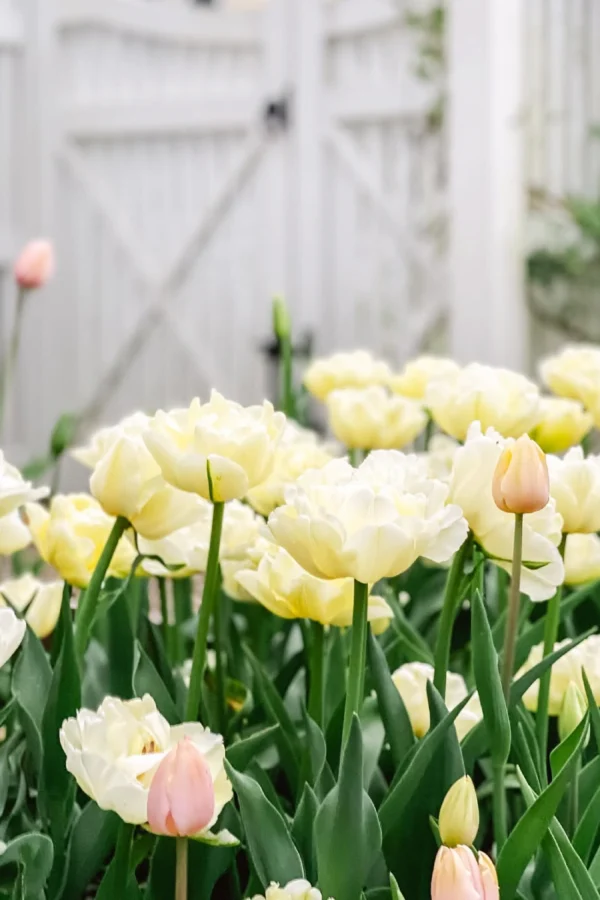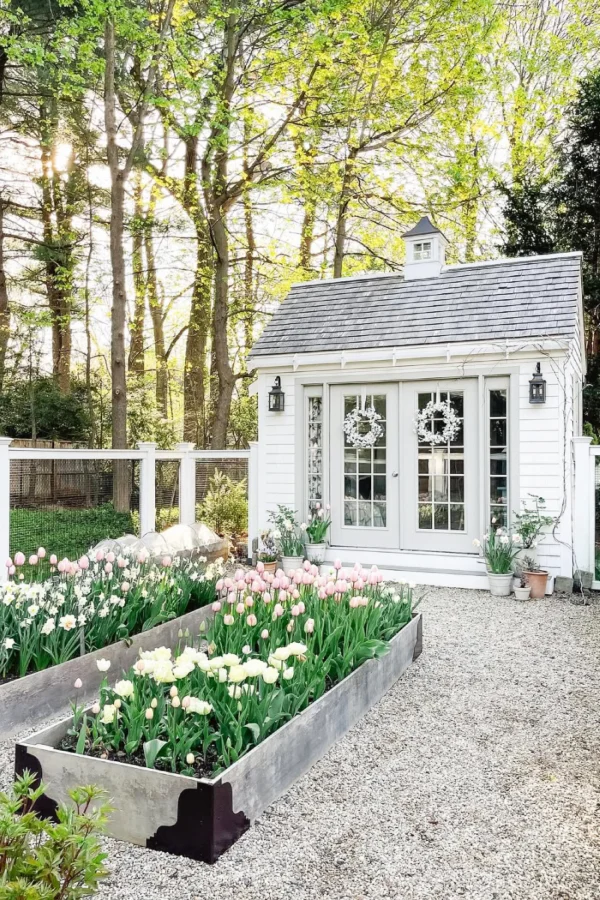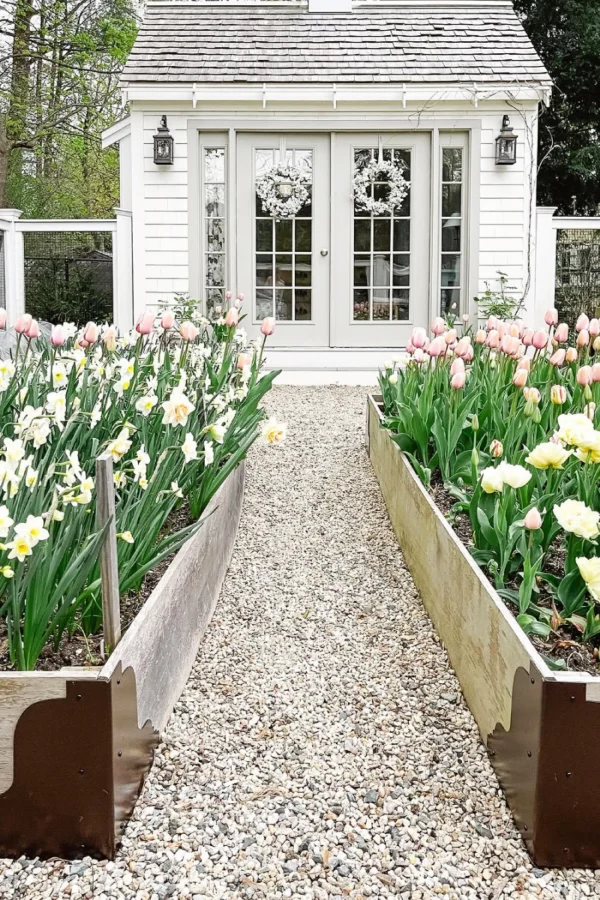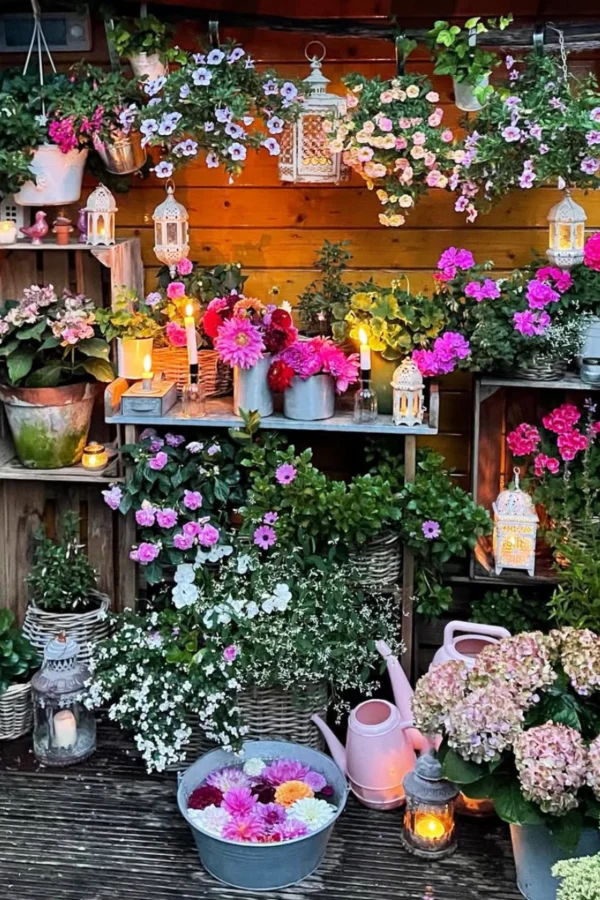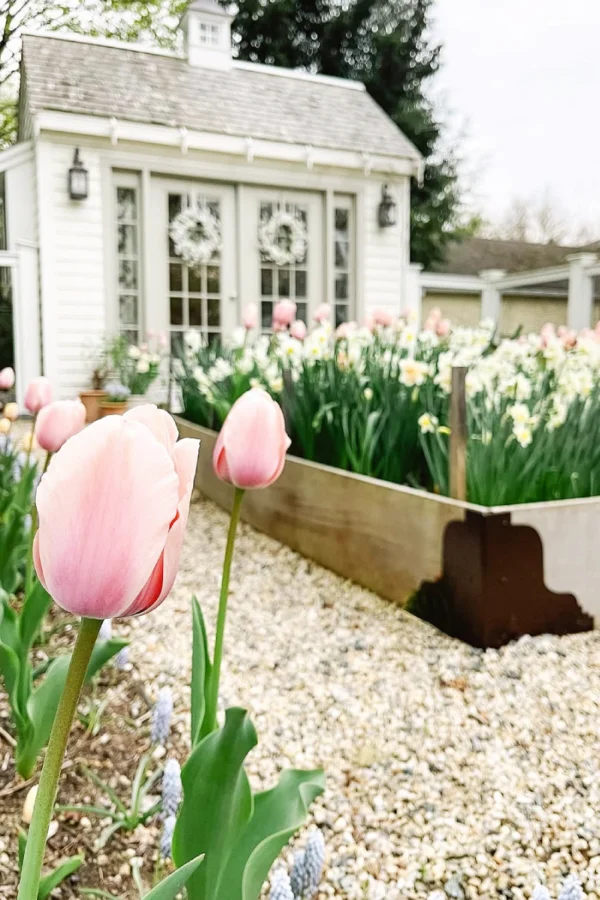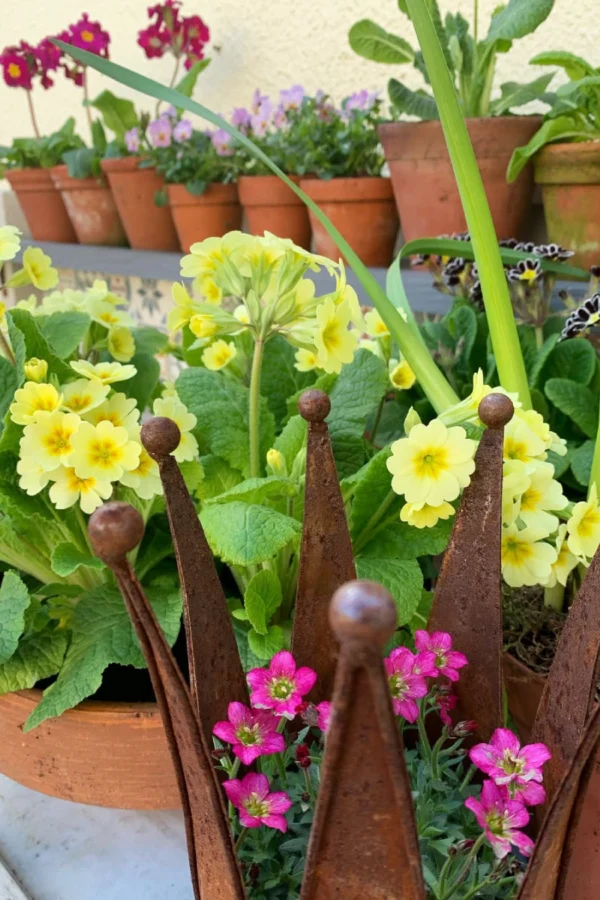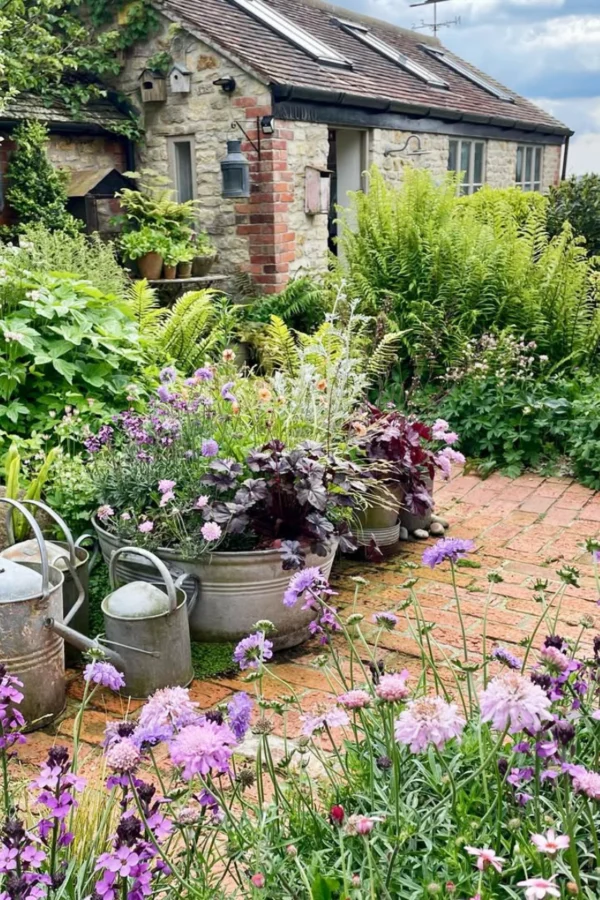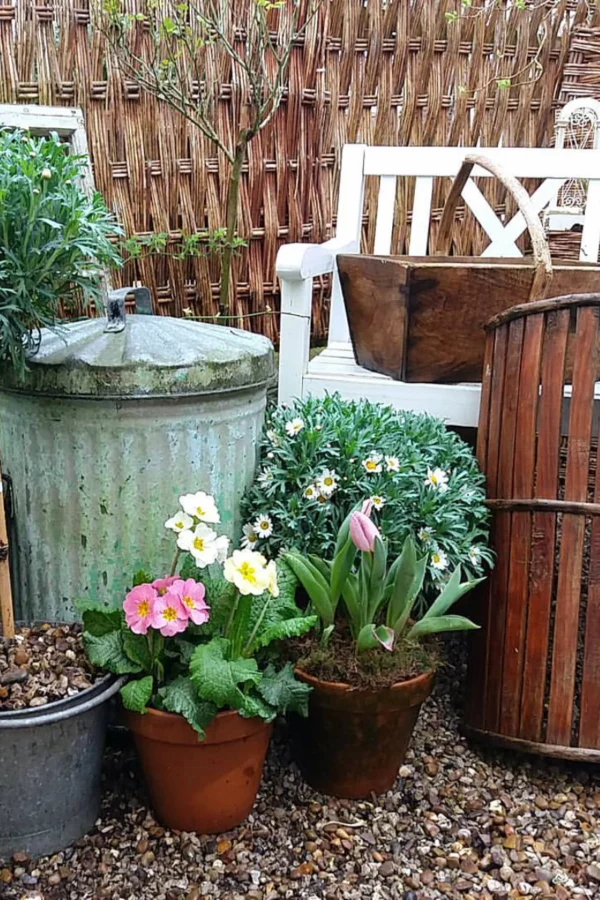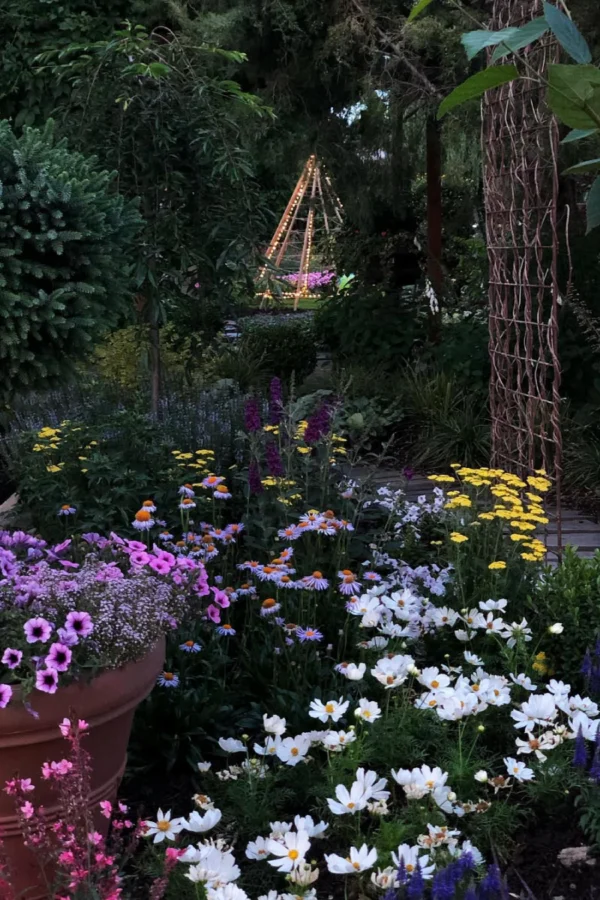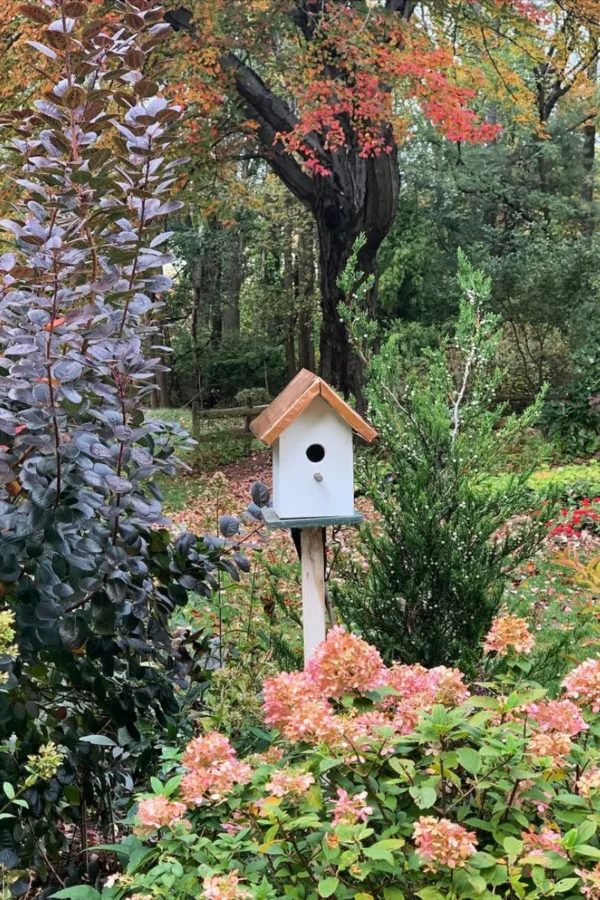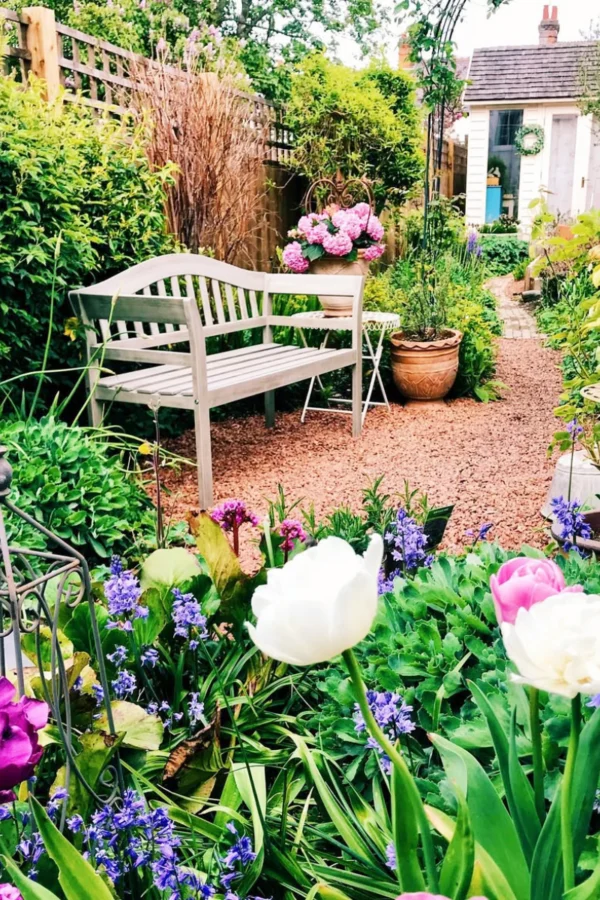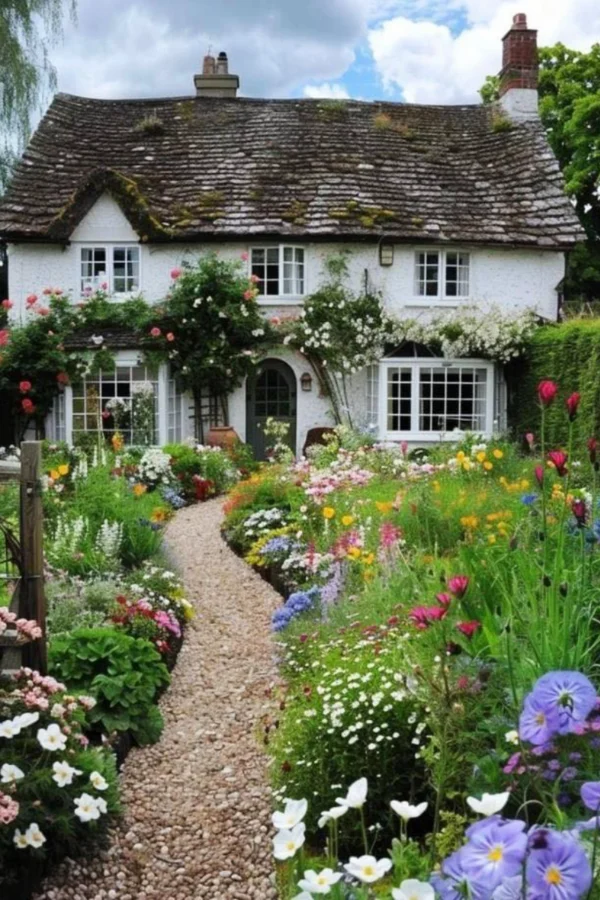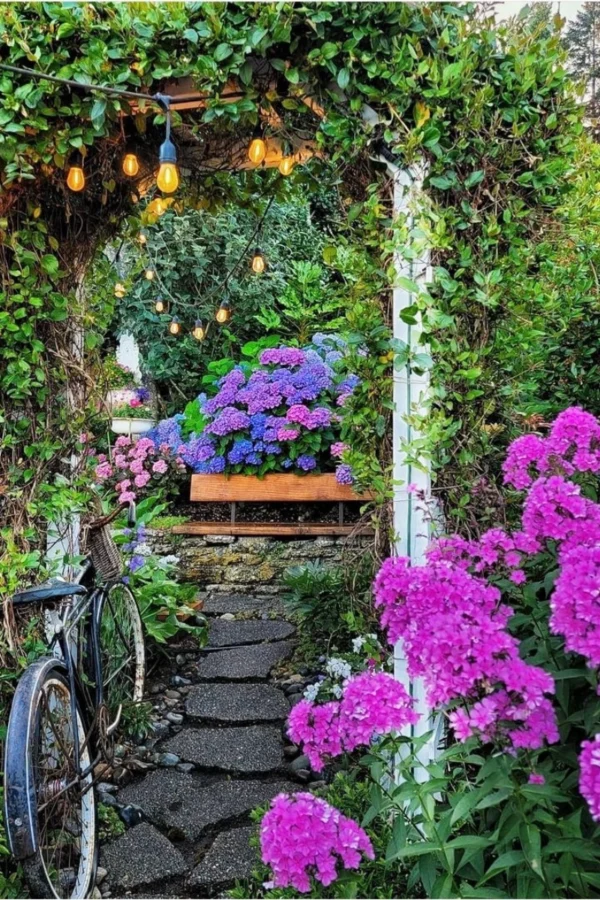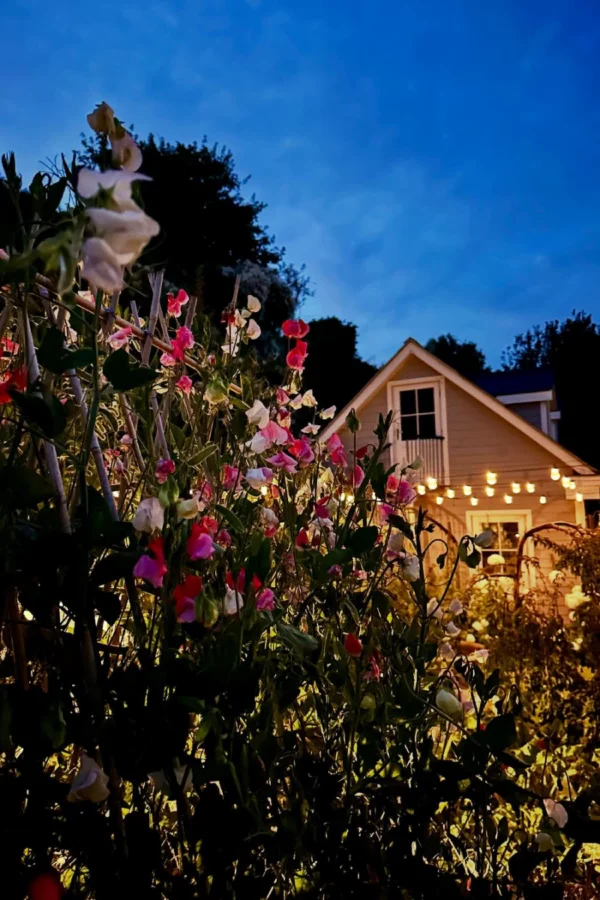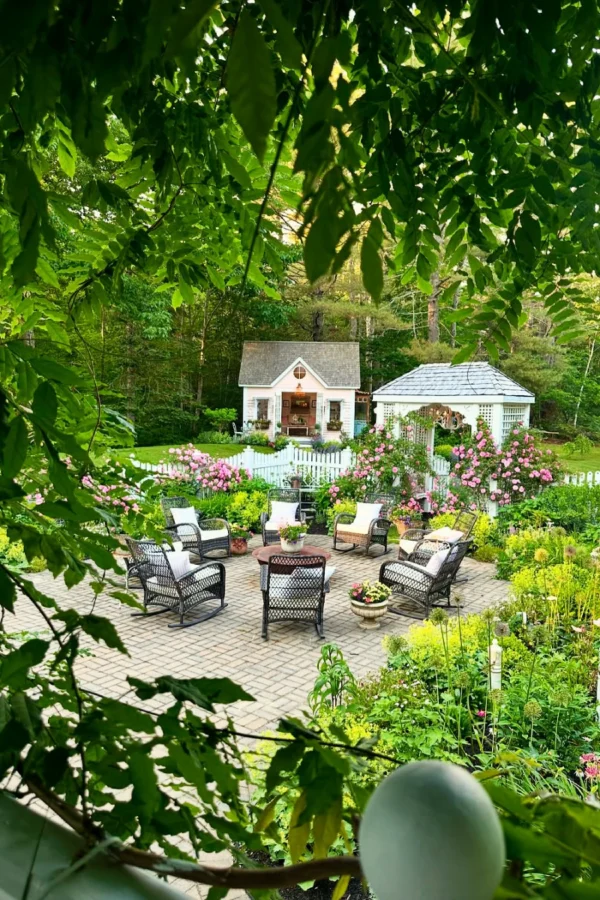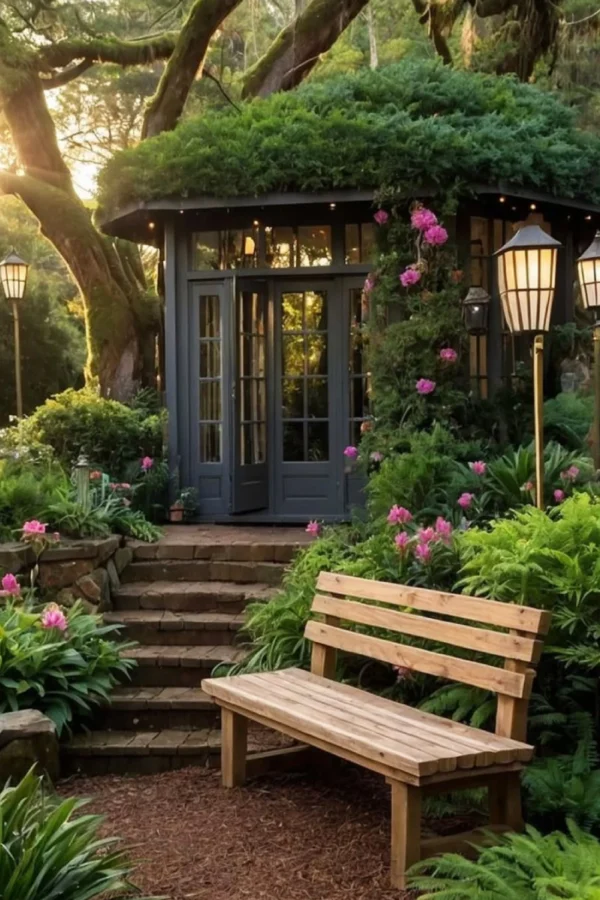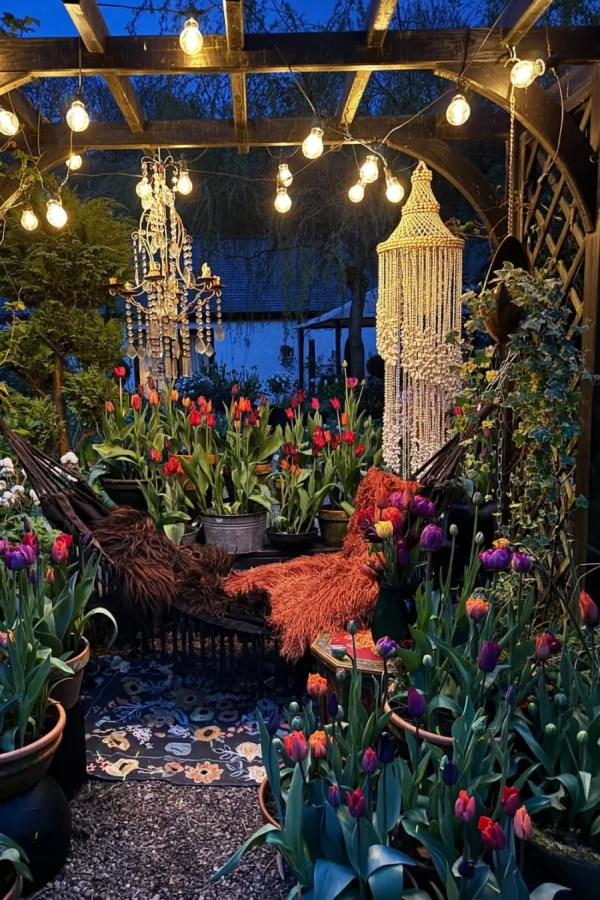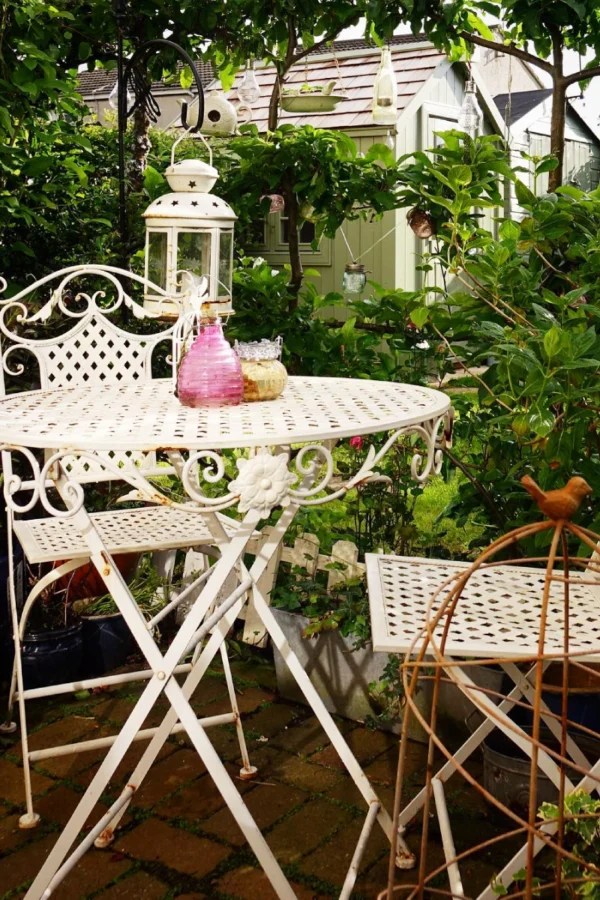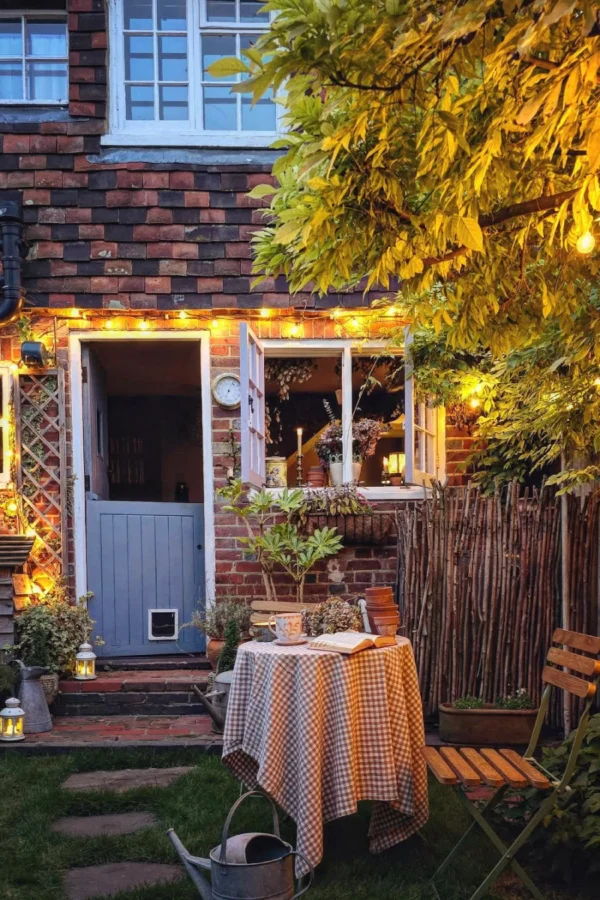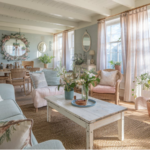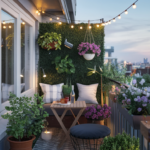This article had me feeling all kinds of FOMO. The kind where you see someone’s effortlessly beautiful life and think, Wait…why don’t I live like that? There were gardens straight out of the rolling hills of Ireland, where everything looks peaceful and poetic, like something out of a movie. It’s a vibe. But then again, there’s Florida at sunrise, where the ocean glows behind palm trees, and the air feels like a warm hug. Honestly? I want both. Just let me bounce between them and soak in all the different ways people get to exist in their own little corners of the world.
Now, picture this. Pastel tulips swaying in the breeze. The soft crunch of gravel underfoot. A quaint white garden shed with French doors and a wreath that looks like it belongs in a Hallmark movie. That’s the charm of a small cottage garden, and let me tell you—I found a ton of images that capture that exact feeling. It’s not just landscaping. It’s a storybook moment brought to life, no matter how big or small your space is.
This blog is your go-to guide for crafting a ridiculously charming cottage garden—without breaking the bank. Whether you’ve got a backyard, a tiny home, or just a little outdoor nook begging for some personality, this is for you. I could’ve spent all day scrolling through dreamy garden photos, but at some point, I had to cut myself off. Too many meandering pathways, cozy seating spots, and vintage flower beds that made me want to pack up and move to the countryside immediately.
But lucky for us, you don’t need rolling hills or an English estate to get the cottage garden look. With a little creativity (and maybe some shabby chic decor you already have lying around), you can turn any space into a storybook escape. Whether you’re working with a courtyard, a balcony, or a small backyard, this is all about bringing that whimsical, cozy charm right to your doorstep.
Section 1: Planning and Choosing Your Small Cottage Garden Space
Start with the Right Location
Like any garden, location is everything. Most cottage garden plants love full sun, so find a spot that gets plenty of it. But if your space leans more shady retreat than sun-drenched meadow, don’t stress. Hostas, ferns, and foxgloves thrive in lower light and bring so much personality to a space.
And while you’re scouting the perfect spot, check out your soil too. Healthy plants start with healthy soil, so consider mixing in compost or mulch to give everything a nutrient boost. (Bonus: Composting with kids? Surprisingly fun. Messy? Absolutely. Worth it? Always.)
Also, think about accessibility—especially if you’re adding pathways, seating areas, or raised beds. You don’t want to be tiptoeing through the flowers every time you water. A little planning now means less frustration later.
Designing a Layout That Feels Expansive (Even in a Small Space)
A good layout is the secret to making a small garden feel way bigger than it actually is. It’s like rearranging furniture—a few smart changes, and suddenly everything feels more open and inviting.
Picture this: A winding gravel path (or a perfectly symmetrical one, if you like things neat) weaving through raised flower beds bursting with pastel tulips and cheerful daffodils. Those raised beds? Framed with rustic metal brackets for a little extra charm. And the pathway? It’s not just there to guide your feet—it guides the entire experience. Even the smallest garden feels intentional when it has a clear flow.
For an extra touch of storybook magic, add a central focal point. I came across a quaint white garden shed with French doors and a wreath, and I’m convinced every cottage garden needs something like it. Maybe it’s a painted gate, a vintage birdbath, or a trellis covered in climbing roses. Whatever it is, it anchors the space visually and instantly ups the charm factor.
What Do You Want Your Garden to Be?
Before you start digging, ask yourself what you actually want from this space.
- A peaceful retreat for morning coffee? Add a tucked-away bistro table surrounded by blooms.
- A vibrant flower and herb garden? Include a mix of seasonal flowers, lavender, and maybe a potted rosemary or two.
- A dreamy backdrop for entertaining? Incorporate meandering pathways and a seating nook, plus a few soft ground covers like creeping thyme to fill in gaps and make everything feel lush.
Or maybe it’s all three, and you just need to make space for everything you love. That’s the beauty of a cottage garden—there are no rules, just layers of beauty that feel perfectly imperfect.
Section 2: Shabby Chic and Decorative Touches for Your Cottage Garden
Cottage Garden Meets Shabby Chic: Vintage Charm with a Dash of Whimsy
Cottage gardens and shabby chic go together like tea and biscuits, lace and ruffles, or me and impulsively buying yet another flower pot I don’t need. This dreamy aesthetic is all about vintage charm, soft pastels, and upcycled treasures that make any space feel like a storybook hideaway.
Bringing Vintage Charm to Your Garden
Shabby chic cottage gardens thrive on nostalgia—the more charmingly weathered, the better. There are endless ways to pull this off, and the best part? It doesn’t have to be perfect to be beautiful.
Picture this: A vibrant red cottage draped in ivy. A cheerful yellow door, framed by cascading floral arrangements. Window boxes bursting with color. A whimsical birdhouse tucked between the blooms. It’s cozy, inviting, and just the right amount of lived-in magic.
For extra character, sprinkle in vintage finds like:
- Rusty watering cans overflowing with trailing flowers
- Galvanized tubs doubling as plant beds
- Lanterns with intricate cutouts casting dreamy shadows at dusk
These small details breathe life into a space, making it feel cozy, romantic, and effortlessly charming.
Pastels + Rustic Textures = Cottage Garden Perfection
A soft, airy color palette is what gives shabby chic its signature look. Think:
- Blush pink tulips swaying in the breeze
- Pale yellow primroses nestled in vintage crates
- Powdery blue delphiniums standing tall against a white garden shed
Now mix those delicate colors with textures that tell a story. Weathered wood, wrought iron trellises, and distressed finishes create contrast, making pastels feel even more inviting. A gravel pathway lined with wildflowers, an antique ladder repurposed as a planter, or a wicker basket filled with blooming daisies adds just the right balance of refinement and rustic charm.
Upcycling: Budget-Friendly Garden Magic
The heart of shabby chic design? Making something beautiful out of something old. And honestly, it’s kind of a thrill.
- An old wooden crate? Now it’s a planter.
- A vintage metal trash bin? Perfect for trailing ivy.
- A rusty gate? Trellis material for climbing roses.
Even something as simple as string lights or lanterns can turn a basic garden into a magical escape. Imagine a cozy seating nook illuminated by warm glowing lights, surrounded by blooms and the soft hum of evening crickets. It’s effortless. It’s inviting. It’s exactly where you want to be at the end of a long day.
Why It Just Works
Shabby chic isn’t just about decorating—it’s about creating a feeling. It turns a garden into more than just a collection of plants. It makes it a space that tells a story.
Maybe it’s a cluster of terracotta pots, an old bench softened by cushions, or a red cottage framed with climbing roses. Whatever it is, it feels personal. It invites you to slow down, take a breath, and just be.
Close your eyes, breathe in the scent of fresh blooms, and let yourself fall into the story of your own garden.
Section 4: Creating Whimsical Features in a Cottage Garden
Adding whimsical touches to a cottage garden is like giving it a personality—one that’s a little quirky, a little charming, and fully enchanting. These playful details make the space feel alive, with hidden surprises and focal points that invite you to linger just a little longer.
Focal Points That Spark Joy
Whimsical focal points don’t just add decoration; they tell a story. A well-placed birdhouse, a vintage bicycle tucked into the blooms, or a trickling fountain instantly makes a garden feel more inviting. And depending on the colors already weaving through the flowers, these little accents can add just the right amount of pop.
Imagine a rustic wooden birdhouse nestled in the middle of an autumn-kissed garden, surrounded by pink hydrangeas and fiery red and gold foliage. Birds fluttering in and out, adding movement and sound to the space. Now shift the scene—a bright blue birdhouse standing proudly among clusters of foxgloves, pink carnations, and lavender-hued wildflowers. The contrast of color and texture makes it a natural showstopper, blending into the landscape while standing out just enough to catch the eye.
For even more charm, pair these features with natural elements. A weathered stone tucked beside a climbing rose, a repurposed watering can overflowing with petunias, or the pale white bark of a birch tree offering the perfect contrast to deep green leaves. Details like these help a garden feel layered, lived-in, and full of life.
The Beauty of the Unexpected
Whimsical gardens thrive on the little surprises—the objects that feel like they just belong even though they weren’t originally meant for a garden. Antique containers, rustic terracotta pots, and even old furniture repurposed into planters add a cozy, unpretentious vibe.
This became crystal clear while scrolling through endless garden images. Some of the best spaces were filled with things that might have otherwise been tossed. A vintage wheelbarrow overflowing with trailing ivy. A set of old teacups used as tiny planters. A wooden ladder leaned against a fence, with colorful pots balanced on each step. None of it felt forced, yet every piece added character.
One of the most magical ideas? A softly glowing teepee structure tucked into a bed of wildflowers. Picture the warm light spilling through, casting a dreamy glow over purple foxgloves, white daisies, and golden buttercups. A terracotta pot overflowing with pink blooms nearby grounds the scene in something familiar, balancing the fairy-tale effect with a rustic, earthy touch.
Hidden Nooks That Feel Like a Secret Garden
Every whimsical garden needs a little mystery—something that makes it feel like stepping into another world. Framing a tucked-away corner with climbing vines or dense foliage instantly makes it feel like a secret waiting to be discovered.
A hidden bench under the shade of an arching tree. A cozy reading nook surrounded by roses and flanked by an antique lantern. A winding path that suddenly opens up to a tiny table set for two, complete with mismatched chairs and a soft candle glow. These details don’t just add beauty—they invite you to explore, making the garden feel like it’s revealing itself bit by bit.
Why It Works
Whimsical features bring a garden to life in a way that’s both playful and intentional. A well-placed birdhouse, a glowing teepee, a repurposed treasure—all of these elements turn a simple outdoor space into a place that feels lived-in, personal, and a little bit magical. Cottage gardens aren’t about rules. They’re about stories, nostalgia, and finding delight in the unexpected.
Section 5: Whimsical Cottage Garden Paths and Vertical Interest
Cottage garden paths and vertical accents do more than just look pretty. They guide, frame, and sprinkle in a little bit of that “I might accidentally stumble into a fairytale” kind of magic. A winding path invites you to wander, while trellises, arches, and climbing plants add height and drama. Together, they make a garden feel layered, cozy, and full of charm.
Meandering Paths That Beg You to Explore
A path isn’t just a way to get from point A to point B. It’s a slow invitation to take your time, soak in the flowers, and maybe stop mid-stride because a butterfly just landed on a daisy. A well-placed walkway turns a garden into an experience, leading visitors (or just you, coffee in hand) on a scenic stroll through blooms and greenery.
Picture a gravel path lined with pink and purple foxgloves, winding its way to a white cottage with ivy creeping up its stone walls. The soft crunch underfoot, the scent of lavender brushing past, the feeling that you’re stepping into something timeless. Stone pavers, brick walkways, or even wood slices can all set the tone—whether you want quaint and cozy or a little more wild and whimsical.
Want an extra layer of charm? Scatter wildflowers along the edges. Let creeping thyme weave between stones. Tuck in tiny solar lanterns for a glow that lingers long after sunset. Paths should feel like an invitation, not just a way to avoid stepping in mud.
Let’s Talk Vertical: Arches, Trellises, and Climbing Flowers
Vertical elements bring drama. Not in the reality TV way—more in the “Wow, this garden has layers” kind of way. A trellis draped in climbing roses? Instant romance. A vine-covered arbor over the entrance? Feels like you’re stepping into a secret garden.
A simple wooden trellis against a shed, covered in sweet peas or morning glories, adds color and movement. String lights wrapped around a rustic archway give off the softest, dreamiest glow. Even a tucked-away bench under a canopy of climbing hydrangeas can turn a garden corner into a cozy little hideaway.
For a touch of nostalgia, lean an old wooden ladder against a fence and let vines wind their way up. Or, place a vintage bicycle near a trellis, its basket overflowing with petunias or ivy. Small, unexpected details like these bring personality to a space—like the garden is telling a story that’s been unfolding for years.
Blending Paths with Blooms for That Picture-Perfect Look
The best garden paths aren’t just surrounded by flowers. They’re practically swallowed by them. Gravel, brick, or stepping stones should feel like they belong—woven between clusters of lavender, tucked under drooping wisteria, or winding between rose bushes heavy with blooms.
Mix and match textures to keep things interesting. A mossy stone path leading to a bench, flanked by cottage-style flower beds bursting with hollyhocks and daisies, feels straight out of a storybook. Wooden fences lined with climbing vines create a natural frame, drawing your eye deeper into the garden.
For an extra dreamy touch, add low-growing plants along the edges—something like creeping phlox or alyssum to soften the borders. The goal? A garden that feels like it’s spilling over with life, where every turn holds another quiet, beautiful moment.
Why It Works
Paths and vertical elements add structure without feeling stiff. They guide movement, frame views, and create little moments of discovery. Whether it’s a tucked-away reading nook under a climbing rose or a winding stone path leading past a wildflower meadow, these features shape the experience of a garden.
A cottage garden isn’t about perfection. It’s about charm, character, and a little bit of planned-overgrown chaos. And with a path to follow and a trellis to climb, the space isn’t just beautiful—it’s inviting, alive, and full of stories waiting to be told.
Section 6: Cozy Seating Areas and Styled Nooks in Cottage Gardens
Cottage Garden Seating: Cozy Nooks & Charming Escapes
A cottage garden isn’t just about the flowers—it’s about the moments you spend among them. A morning cup of coffee tucked into a vine-covered corner, an afternoon daydream in a sun-dappled hammock, a quiet evening wrapped in a blanket with fireflies flickering in the distance. A well-placed seating area turns your garden into a retreat, inviting you to linger, unwind, and let the world slow down for a while.
Choosing Furniture That Feels As Good As It Looks
Garden seating should be two things: sturdy enough to survive the elements and charming enough to feel like it belongs in a storybook. Wrought iron tables and chairs never go out of style, with their curved edges and intricate details that practically beg for a floral centerpiece and a good book. Imagine a little bistro set nestled beneath a canopy of hanging lanterns and twinkling fairy lights, surrounded by climbing vines and the occasional butterfly. It’s giving pure magic.
For a more laid-back vibe, wicker chairs around a fire pit strike the perfect balance between comfort and charm. Add some fluffy cushions, a soft throw blanket, and maybe even a few marshmallows, and suddenly your garden has become the coziest corner of the world. Picture roses tumbling over a white picket fence, the golden glow of lanterns casting soft shadows, and a warm evening breeze carrying the scent of lavender and jasmine.
Layering with Textiles & Greenery for Ultimate Coziness
Seating isn’t just about the chairs—it’s about what surrounds them. A wooden bench framed by cascading pink roses, a hammock swaying gently under a pergola, or a plush daybed tucked beneath a trellis covered in wisteria all invite you to sink in and stay a while.
- Cushions & Throws: A bench is just a bench—until you add a plush seat cushion, a cozy throw, and maybe a few mismatched pillows for that effortlessly charming look.
- Rugs & Runners: A patterned outdoor rug under a shady pergola instantly makes the space feel more inviting (and keeps toes from burning on hot stone).
- Surrounding Greenery: The best seating areas blend into the garden, not sit apart from it. A vintage iron chair hidden in a bed of wildflowers? A swing wrapped in ivy? A bench tucked beneath a flowering archway? Yes, please.
Private Nooks & Hidden Escapes
Some spaces are meant for gathering, but others? They’re made just for you. There’s something magical about finding a hidden corner in a garden—a place to sit, breathe, and let the world melt away.
- The Secret Garden Bench: A quiet bench, tucked behind a trellis covered in roses, with soft candlelight flickering nearby. Pure magic.
- The Hammock Hideaway: A breezy retreat with a plush hammock, layered with soft throws, hidden behind a curtain of cascading wisteria.
- The Fire Pit Corner: Surrounded by cozy seating, flickering lanterns, and a glass of something delicious. The kind of space that makes you want to stay up past your bedtime.
The best cottage gardens don’t just look beautiful—they feel like a place you want to be. They invite you in, wrap you in their charm, and make it impossible to leave.
Why It Works
Seating areas bring life to the garden. A chair under a tree, a bench next to a flower-filled shed, or a hammock swaying in the breeze turns a pretty space into a place you can truly enjoy. It’s not just about function—it’s about feeling at home.
Because at the end of the day, a garden isn’t just about growing flowers—it’s about growing moments you never want to forget.
Section 7: Lighting Ideas for a Magical Evening Garden
Cottage Garden Glow: How to Light Up Your Outdoor Escape
Once the sun clocks out for the day, lighting steps in to keep the magic going. The right glow turns a charming cottage garden into a nighttime wonderland, perfect for late-night chats, solo unwinding, or just an excuse to stay outside a little longer. With a mix of twinkling string lights, rustic lanterns, and soft solar glows, you can add warmth, depth, and just the right amount of whimsy to your space.
String Lights: The Ultimate Garden Glow-Up
String lights are the fairy godmother of garden lighting—simple, affordable, and instantly magical. Wrap them around arches, trellises, tree branches, or even weave them through your pergola for a warm, inviting glow.
- A rose-covered archway dripping in soft white lights? Feels like stepping straight into a storybook.
- A winding stone pathway lined with twinkling strands? Suddenly, a casual stroll turns into a main-character moment.
- String lights over a cozy seating area? Every night feels like a backyard café date.
Picture this: pastel tulips swaying in the evening breeze, their soft pink and cream petals illuminated by a golden glow from above. Raised flower beds, a quaint wooden fence, and the flicker of candle lanterns nearby? Absolute garden perfection.
Lanterns, Fairy Lights & Solar Magic
There’s something about lanterns that immediately makes a space feel both rustic and elegant. A little wooden bistro set tucked in the corner, gingham tablecloth, open book, and a flickering lantern nearby? That’s an end-of-the-day dream.
- Hanging lanterns from tree branches? Soft, golden pools of light everywhere.
- Fairy lights woven into shrubs? Like tiny fireflies that never leave.
- Solar-powered path lights? Just enough glow to keep the mood cozy without any effort.
And the best part? Solar options do all the work for you. No cords, no plugs—just pop them in, let the sun do its thing, and enjoy the effortless glow-up every evening.
Layering Light for the Ultimate Cottage Garden Vibe
The secret to truly dreamy garden lighting? Layers.
- Overhead glow – String lights or hanging lanterns create a warm foundation.
- Mid-level ambiance – Table lanterns, fairy lights, or sconces add depth.
- Ground-level charm – Solar stake lights or candles tucked into flower beds bring soft flickers of light from below.
Picture this: a softly glowing greenhouse as the garden’s centerpiece, greenery reflecting the warm light, with a quaint blue cottage in the background and a spiral staircase curling up to a lantern-lit balcony. The kind of scene that makes you want to stay outside just a little longer.
Why It Works
Lighting does more than just make things visible—it adds mood, magic, and a reason to linger outside well past sunset. The right mix of warm glows, soft shadows, and charming details makes your garden feel inviting, peaceful, and absolutely enchanting every single night.
Section 8: Greenhouse Inspiration for Cottage Gardens

The Greenhouse Glow-Up: Because Your Garden Deserves a VIP Lounge
A greenhouse isn’t just a place to keep plants happy. It’s a backyard showstopper, a plant-loving paradise, and possibly the best excuse yet to hoard more greenery. Whether you’re dreaming of a charming glasshouse with vintage vibes or a DIY potting shed that oozes character, adding one to your garden isn’t just functional—it’s a full-blown garden upgrade.
Tiny But Mighty: Greenhouses for Small Spaces
Think your garden is too small for a greenhouse? Hard pass. Compact options like lean-tos, cold frames, and mini-greenhouses tuck into corners, patios, or even up against a wall. Now, imagine a cozy little greenhouse, glowing at dusk, tucked between raised beds brimming with fresh herbs and cheerful wildflowers. Tall foxgloves sway in the breeze, geraniums burst with color, and suddenly—it’s like your backyard got its own fairytale upgrade.
These petite powerhouses don’t just grow plants—they steal the show. Frame yours with climbing roses, ivy-covered trellises, or a rustic stone path, and it’ll look so effortlessly charming, guests will assume it came with the house.
DIY Potting Sheds & Mini-Greenhouses: Budget-Friendly Magic
If rolling up your sleeves and making something from scratch is your idea of a good time, a DIY greenhouse or potting shed is calling your name. Think old windows, salvaged wood, and a little creative problem-solving—you’ll end up with a greenhouse so full of charm it practically hums a folksy garden tune.
Want to take it up a notch?
- Frame it with climbing vines so it looks like Mother Nature just casually put it there.
- Add a rustic potting bench stocked with rows of seed packets, vintage garden tools, and more watering cans than anyone realistically needs.
- Hang string lights or solar lanterns so it glows like an enchanted cottage at night.
Even a simple setup feels like magic when you sprinkle in thoughtful details.
Why It Works
A greenhouse is practical—it extends the growing season, protects delicate plants, and gives you a spot to fuss over seedlings year-round. But beyond that? It’s a whole vibe.
It adds warmth, character, and a touch of that dreamy English cottage garden magic. And honestly? It just makes gardening even more fun.
Giving Your Greenhouse That Cottage Garden Charm
A greenhouse in a cottage garden isn’t just for keeping plants warm. It’s a showpiece, a cozy hideaway, and a sign to the world that yes, you’re officially a person who says things like ‘I’ll just be out in the greenhouse’ with a straight face. But to really make it shine, styling matters.
Instead of letting it sit there looking like a glorified storage shed, blend it into the garden. A few well-placed foxgloves, some potted geraniums, and a lavender border will make it feel like it’s always belonged. Weathered wooden potting tables, galvanized watering cans, and terra-cotta pots overflowing with herbs add warmth inside. It’s all about making the space feel charmingly lived-in, like a gardener with a great hat is about to walk in and start pruning something.
And when the sun sets? That’s when the magic happens. A string of warm fairy lights draped over the frame turns it into a glowing garden centerpiece. The mix of soft light, vibrant blooms, and lush greenery makes it impossible not to stop and take it all in.
Why It Works
A greenhouse isn’t just useful—it’s part of the garden’s personality. It extends the growing season, protects delicate plants, and gives you a quiet space to tinker with seedlings like a proud plant parent. But styled right, it becomes a focal point that ties everything together, making the entire garden feel like something out of a storybook.
The Cottage Garden Dream
A cottage garden isn’t about perfection. It’s a little wild, a little whimsical, and completely personal. Winding paths, bursts of color, and tucked-away seating areas all work together to make a space that feels both practical and enchanting.
And the best part? You don’t need a sprawling estate to make it happen. Whether you’re working with a tiny backyard, a patio nook, or even a balcony, cottage garden charm can fit anywhere. Upcycled finds, budget-friendly greenhouse ideas, and clever layouts mean you can have that dream garden without spending a fortune.
Now’s the time to get started. Plan, plant, and make it your own. And if you do? You better believe we want to see it. Share your progress, your favorite blooms, and the little touches that make your space feel like home.
FAQ
What is the 70/30 rule in gardening?
The 70/30 rule in gardening refers to allocating 70% of a garden to permanent plants, such as perennials, shrubs, and trees, while leaving 30% for seasonal or annual plants. This balance ensures year-round structure while allowing flexibility for seasonal color and variety.
What plants do you put in a cottage garden?
A cottage garden typically includes a mix of perennials, annuals, climbing plants, herbs, and flowering shrubs. Common plants include roses, foxgloves, delphiniums, hollyhocks, lavender, daisies, peonies, and clematis. Herbs like thyme, rosemary, and chives are also common, along with fruiting plants such as strawberries and espaliered fruit trees.
What is the structure of a cottage garden?
Cottage gardens have an informal, densely planted layout with a mix of flowers, vegetables, and herbs. They often feature winding paths, climbing plants on trellises or arbors, layered plant heights, and naturalistic groupings of flowers. Structural elements may include picket fences, stone pathways, and rustic seating areas to enhance the charm and functionality of the space.
What is the difference between a cottage garden and an English garden?
A cottage garden is informal, densely planted, and typically includes a mix of flowers, vegetables, and herbs in a small space. It often has a natural, unstructured feel with plants growing closely together. An English garden, also known as an English landscape garden, is more expansive and designed with carefully planned views, rolling lawns, water features, and larger plant groupings, often incorporating formal elements and symmetry.
What is the 10-20-30 rule for planting?
The 10-20-30 rule suggests planting garden beds with a mix of plant heights for visual balance. It advises using 10% tall plants for height and structure, 20% medium-height plants for layering, and 30% low-growing plants for ground cover, leaving the remaining space for pathways or filler plants.
What is the color scheme for a cottage garden?
Cottage gardens often use a soft, romantic color palette with pastels such as pink, lavender, white, and light blue. They may also incorporate rich jewel tones like deep purple, burgundy, and bright yellow for contrast. The mix of colors is typically natural and blended rather than structured, creating a relaxed and charming aesthetic.
How big of a garden do you need to sustain one person?
The recommended garden size to sustain one person varies based on diet, climate, and gardening methods. A general guideline is 200 to 400 square feet per person for a vegetable garden to provide a year-round supply of produce. If preserving food for winter, about 4,000 square feet may be needed to ensure self-sufficiency.
What is the garden rule?
“The garden rule” can refer to different principles depending on the context. In general, it often relates to gardening guidelines for plant spacing, sun exposure, soil health, and seasonal care to ensure optimal plant growth. Common rules include crop rotation, companion planting, and seasonal maintenance to promote a healthy and productive garden.

